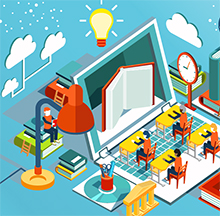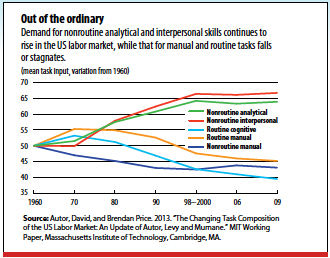Education for Life
Finance & Development, June 2017, Vol. 54, No. 2
Labor markets are changing, and millennials must prepare and adjust

One in three people around the world was born between 1980 and the early 2000s. Most of these millennials are in the workforce. Yet their work future won’t look much like the world of their parents.
Technological advancement is transforming the way we live and the way we work. Although previous generations may have experienced significant technological changes, millennials likely will have to cope with much faster disruption. This means that many, if not most, will need to retool and learn new skills several times during their working life.
The implications for education are critical. The 2016 World Economic Forum Future of Jobs report estimates that up to 65 percent of children entering primary school today are likely to work in jobs that do not yet exist. So not only must education adapt to the needs and attributes of future workers, it must also anticipate and prepare them with the skills to flourish in an evolving workplace. Only then can the race between humans and machines give way to collaboration that harnesses the power of technology to benefit individuals and societies.
Changing workplace
Technology is already changing industries and occupations in many countries. Some of the most in-demand jobs were not even around 10 years ago. Think app developer jobs, which emerged with the advent of smartphones, or the cloud computing of more than half of US businesses. Evans Data Corporation estimates that there were 12 million mobile application developers in 2016—by 2020 there are expected to be 14 million.
Developments in previously disjointed fields are merging and amplifying each other. Artificial intelligence and self-teaching computer programs that replicate human skills are combining with other technologies, such as sensors, to produce self-driving cars and trucks. Such innovations usually require a parallel transformation in workers’ skills to implement the new technology and business models.

David Autor and others at the Massachusetts Institute of Technology find that the demand for higher-order cognitive skills—including numeracy, literacy, and problem solving in technology-rich environments—increases with an economy’s technological sophistication. In the United States, the surge in demand for nonroutine jobs between 1980 and 2000 coincided with greater investment in the knowledge economy’s infrastructure; demand for routine and manual jobs declined steadily (see chart). This shift will only accelerate.
These trends are not unique to the United States nor to millennials. Technology is also causing job dislocation elsewhere in the world and affects many age groups. Between 1991 and 2014, the share of income going to labor—as opposed to owners of capital—declined in 29 of the largest 50 economies, according to the IMF’s April 2017 World Economic Outlook. Middle-skilled labor (most likely baby boomers) experienced the sharpest declines in income share, especially in advanced economies and in easily automated sectors such as manufacturing, transportation, and communications. Technology in particular accounted for about half of the decline in advanced economies.
A knowledge economy
A closer look at employment trends in science, technology, engineering, and math (STEM) occupations in the United States confirms that there is a premium associated with the higher-order skills needed in a knowledge-based economy. According to the Census Bureau, close to 9 million workers were employed in STEM occupations in the United States in 2015, representing more than 6 percent of workers. These workers also earned 29 percent more than their non-STEM counterparts—an advantage that increased from 26 percent in 2010.
STEM employment growth has outpaced that of non-STEM occupations over the past decade, at 24 percent and 4 percent, respectively. This trend is expected to continue, with STEM occupations projected to grow 9 percent between 2014 and 2024 compared with about 6 percent for other jobs.
While cognitive skills are necessary, they are not all it takes. Soft skills such as teamwork, creativity, adaptability, and social and cultural awareness are just as important. Harvard education and economics professor David Deming finds the strongest job and wage growth in positions that require both hard cognitive skills and soft social skills.
Think of tasks such as management consulting or health care and legal services. These occupations require basic cognitive skills, but they also demand significant human interaction, which cannot be replicated by machines. The jobs of the future will marry science and art, so that humans can work with machines not against them.
In the workplace
But it seems clear that society is not sufficiently preparing workers for the new reality. Millennials as a group feel underprepared for the challenges of the new workplace. A 2017 survey of 8,000 working millennials across 30 countries by consulting company Deloitte found that many did not think college had equipped them with the full range of skills, personal qualities, and experience today’s businesses are seeking. This finding is echoed in a study by McKinsey: 30 percent of graduates surveyed in the United States felt underprepared for the world of work. Employers agreed.
A knowledge- and technology-intensive economy depends on an educational system that prepares students not only to use and complement technology but also to innovate. Studies using standardized competency and proficiency results suggest that some countries may be better prepared than others.
The Organisation for Economic Co-operation and Development (OECD) 2015 Program for International Student Assessment took a deeper look at students’ proficiency in science, reading, and mathematics in 42 countries. Singapore was the top performer across all three subjects, followed by Japan, Estonia, and Taipei. US scores were at the OECD average in science and reading and below average in mathematics. Still, the United States has more than a fifth of the global population of top-performing 15-year-old students.
In a world of massive information flows and rapid change, the workforce of the future will need a well-aligned skill set to keep up. An understanding of science and science-based technology is no longer the domain of scientists; it is essential for any citizen to make informed decisions in everyday life and to foster a culture of lifelong learning.
At the same time, a growing body of literature suggests that information and communication technology has shifted job design within occupations toward arrangements that favor team production, and therefore workers with social skills. A 2016 World Economic Forum report estimates that five years from now, more than a third of skills considered important today will no longer be relevant. Creativity and emotional intelligence will be among the top three needed. Hard cognitive and social skills have always been at play, but the balance is likely to shift in favor of the latter for 21st century workers.
Where learning begins
Clearly, skills—both cognitive and soft—are developed in a variety of settings and evolve with age. But formal education remains the primary source of learning. The challenge here is for the education system to equip students with skills for jobs that do not yet exist. This requires a holistic approach to education and lifelong learning built on a partnership between academic institutions, employers, and government.
The educational system must first adapt to the particular needs and attributes of the millennial generation. And it must tap into the way tech-savvy millennials learn, so that pedagogy can support learning.
Recent studies of millennials suggest that they are not passive listeners; they expect to be engaged in learning. They socialize, study, and collaborate in groups and expect technology to be an integral process in learning. Business professor Roger McHaney, author of The New Digital Shoreline, offers some insight into ways teachers can rise to the challenge of preparing this generation.
For starters, teachers must become a “guide on the side” rather than the “sage on the stage.” They will have to play the role of a master artist—imparting new ideas and information to novices—and network administrator, guiding students as they forge their own learning experiences and ensuring that they have the requisite technical and social skills.
Technology will be a basic feature of the instruction process, according to education expert Persis Ricks. Teachers will be expected to shift seamlessly from a didactic approach to PowerPoint or Keynote presentations to hands-on demonstrations—all in the same class and space. This is essential to nurture the trial-and-error style of a generation more interested in hands-on problem-based learning than passive listening. Many teachers will need training in these new approaches.
Classes of the future will blend online and face-to-face classroom instruction. The rapid increase in massive online open courses at many universities allows students to master material at their own speed and in their own way.
Many skills are acquired outside formal schooling, especially on the job or through training. But as jobs are redefined and lifelong careers at a single employer disappear, retraining and lifelong learning become a fundamental responsibility of individuals rather than employers.
But employers too need to step up. Among working millennials in 30 countries, only a third report that their businesses engage in education, skills, and training. That will have to change if companies want to hold on to their staff.
Policymakers must be at the forefront of an agenda for policy change in education and learning. Korea, for example, adopted a longer-term vision for its education strategy. With 2030 as the target date, the focus of the strategy ranges from improving collective intelligence to use of simulations and mobile technology as research tools to improving learning outcomes through understanding of brain synapses and human nutrition.
Governments can help by offering incentives for retraining, which will be increasingly important as more people are self-employed and unable to afford additional education. About a third of the 53 million freelancing Americans today are millennials; this share is expected to increase even further by 2020 according to the consulting firm PwC, also known as PricewaterhouseCoopers.
Singapore has taken steps in this direction. In its Singapore Skills Future initiative, employers identify skills needed over the next five years, The Economist writes. That information is used to map the skills industries will need in the future; the government then provides financial credits to citizens over 25 to acquire relevant training.
Collaboration, not competition
Most millennials recognize the benefits of automation for productivity and economic growth, according to the Deloitte study, but 40 percent see it as a threat. Not surprisingly, those most willing to engage with new technology had a more positive outlook.
These attitudes mirror the polarization on technological disruption—between those who foresee limitless new opportunities and those who predict massive dislocation of jobs. A win requires educational systems that teach both cognitive and social and emotional skills, businesses that actively support their workforce through retraining and upskilling, individuals who are proactive about lifelong learning, and governments that prepare a supportive environment for these efforts.
The current technological revolution need not become a race between humans and machines. With proper lifelong learning and updating of skills, humans can work with machines to unleash the full potential of technological innovations.


